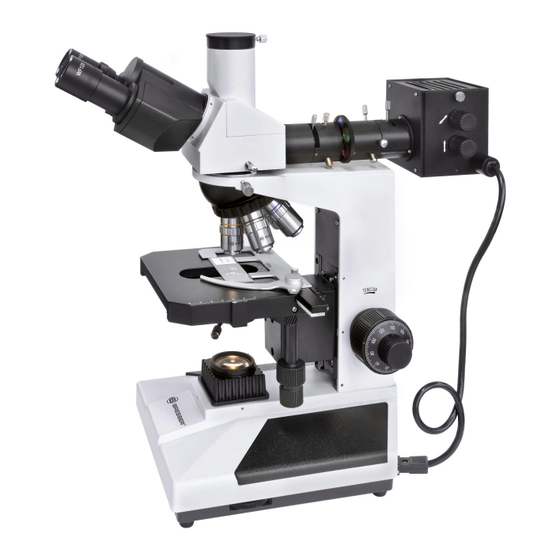
Advertisement
Available languages
Available languages
Quick Links
Bedienungsanleitung
Instruction Manual
BRESSER Science ADL-601P
BRESSER Science ADL-601P
Auflicht- und
Reflection-type and
Durchlicht-Kombinationsmikroskop
Transmission-type Microscope
mit Polarisationseinheit
with Polarization Attachment
Art.-No. 57-70200
Advertisement

Summary of Contents for Bresser Science ADL-601P
- Page 1 Bedienungsanleitung Instruction Manual BRESSER Science ADL-601P BRESSER Science ADL-601P Auflicht- und Reflection-type and Durchlicht-Kombinationsmikroskop Transmission-type Microscope mit Polarisationseinheit with Polarization Attachment Art.-No. 57-70200...
- Page 2 WARNUNG! Für die Arbeit mit diesem Gerät werden häufig scharfkantige und spitze Hilfsmittel eingesetzt. Bewahren Sie deshalb dieses Gerät sowie alle Zubehörteile und Hilfsmittel an einem für Kinder unzugänglichen Ort auf. Lassen Sie Kinder nur unter Aufsicht mit dem Gerät arbeiten! Verpackungsmaterial (Plastiktüten, Gummibänder etc.) von Kindern fernhalten! CAUtION! to work with this microscope, sharp and pointed aids are being used.
- Page 3 Abb./Fig. 1 D E FGH Abb./Fig. 2 1& Abb./Fig. 3 Abb./Fig. 4 2& 3^ 3& 3* 3(...
- Page 4 General Information CAREFUL! Children must not have access to the included chem- About this Instruction Manual icals and liquids. Do not drink the chemicals. Wash Please read the safety instructions in this manual carefully. To hands thoroughly with running water after use. In the event of avoid damage to the unit and the risk of injury, only use this contact with the eyes or mouth, rinse thoroughly with water.
- Page 5 Das „BRESSER Science ADL-601P” ist mit Auflicht- und Abbildungen auch eines weiten Sehfeldes zu bieten. In Durchlicht-Beleuchtungssystemen und einer Polarisations- Forschung, Lehre und Produktion lassen sich mit diesem einheit ausgestattet. Mit den planachromatischen Objektiven Instrument beispielsweise materialkundliche oder apparate- und Weitfeld-Okularen vermag es dem Betrachter scharfe technische Untersuchungen ausführen.
- Page 6 • Beleuchtung: Halogen-Glühlampe (12 V, 20 W) mit Hellig- • Bewegungsbereich des Kreuztisches: 50 mm x 75 mm. keitsregler. • Feinfokussiertrieb: Kleinste Skalenunterteilung 0,002 mm. • Stromversorgung: Wechselstrom 230 V / 50 Hz. • Einstellbereich des Augenabstands: 53 mm – 75 mm. •...
- Page 7 2. Durchlicht-Beleuchtung (Abb. 4 & 7) siertrieb scharf. Im zweiten Schritt beobachten Sie nur durch das linke Okular mit dem linken Auge; hier stellen Sie das Bild Abb. 7 mit dem Dioptrieneinstellring (1) scharf. 5. Grob- und Feinfokussierung (Abb. 9) Abb.
- Page 8 Grob- und Feinfokussiertrieb (21 & 22) ein, um ein scharfes 9b. Auflicht-Beleuchtung (Abb. 11) Bild des Objekts zu erhalten. Wenn Sie mit einem anderen Objektiv beobachten, sollten Sie mit dem Feinfokussiertrieb (22) nachfokussieren. Einen Filter können Sie in den Filterhal- ter (39) einlegen.
- Page 9 Sprache? Dann besuchen Sie unsere Website über nachfolgenden Link (QR Code) für verfügbare KONFORMItÄtSERKLÄRUNG Versionen. Die Bresser GmbH, ansässig in 46414 Rhede/Westf., Guten- bergstr. 2, Germany, erklärt für die ses Produkt die Überein- stimmung mit nachfolgend aufgeführten EG-Richtlinien: EN 61326: 1997 www.bresser.de/5770200...
- Page 10 General Information CAREFUL! Children must not have access to the included chem- About this Instruction Manual icals and liquids. Do not drink the chemicals. Wash Please read the safety instructions in this manual carefully. To hands thoroughly with running water after use. In the event of avoid damage to the unit and the risk of injury, only use this contact with the eyes or mouth, rinse thoroughly with water.
- Page 11 The “BRESSER Science ADL-601P” is equipped with re- of view. The instrument is suitable for knowing something flected and transmitted light systems and a polarization at- about the internal construction of materials and for condition tachment. With the planachromatic objectives and wide field...
- Page 12 • Illumination: 12 V, 20 W halogen lamp, brightness adjustable. • Stage movement range: 50 mm x 75 mm. • Power supply: AC 230 V / 50 Hz. • Minimum division of fine focusing scale: 0.002 mm. • The included filters of the reflected light system are: •...
- Page 13 2. Transmitted illumination (Fig. 4 & 7) 5. Coarse / Fine focusing (Fig. 9) Fig. 7 Fig. 9 Switch for observation / photo mode Analyzer adjusting lever 1. Push the power switch (32) to ”I”; then the illumination po- wer is turned on. 2.
- Page 14 8. observation with polarized illumination (Fig. 1, 3 & 4) 9b. Transmitted illumination (Fig. 11) 1. Push the analyzer rod (26) to bring the analyzer into the working position. 2. When you observe with reflected illumination, put the pola- rizer (3) into its insertion slot and turn the polarizer (3). You can observe the variant light contrast in the field.
- Page 15 4. When not in use Cover the microscope with the dust cover and place it the- Alternatively you can also send an email to manuals@bresser.de re, where it is dry and mouldless. We suggest the storage or leave a message on +49 (0) 28 72 – 80 74-220*. Please...
- Page 16 Bresser GmbH Gutenbergstr. 2 · DE-46414 Rhede · Germany Tel. +49 (0) 28 72 - 80 74-210 Fax +49 (0) 28 72 - 80 74-222 www.bresser.de · service@bresser.de Technische Änderungen und Irrtümer vorbehalten Reservation of technical alterations and errors...















Need help?
Do you have a question about the Science ADL-601P and is the answer not in the manual?
Questions and answers